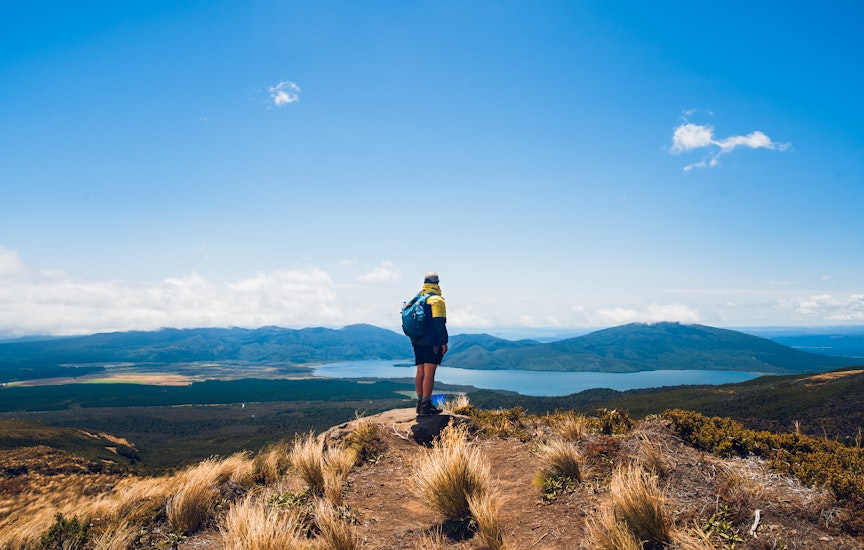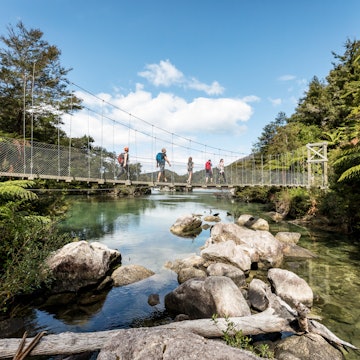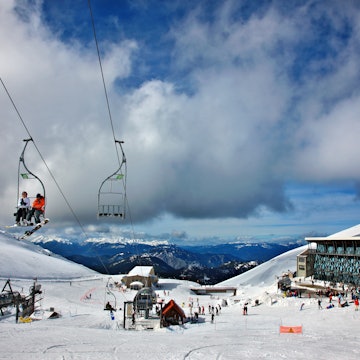
How to hike the Milford Track, one of New Zealand's Great Walks

Nov 20, 2025 • 10 min read

Trampers on the Milford Track through Fiordland National Park, New Zealand. nazar_ab/Getty Images
There are few New Zealand adventures more iconic than the 53.5km Milford Track through Fiordland National Park, which is frequently lauded as the “finest walk in the world.”
Imagine journeying through a valley carved out by ancient glaciers, where – if you’re lucky enough to have a rainy day – literally hundreds of waterfalls will cascade off the towering rock walls on either side of you. You’ll tackle mountain passes, be entirely immersed in lush green environments of native rimu and totara trees, and see sunlight reflecting off emerald green waters. Your final reward is arriving directly into Milford Sound/Piopiotahi. With jagged mountain peaks punctuating the sky and waterfalls that pour directly into the sea, it’s one of New Zealand’s dreamiest natural environments.
I’ve hiked all over Aotearoa (NZ’s Māori-language name) and I can tell you – without a question – that the Milford Track fully lives up to the hype. It’s a walk that will make you feel insignificant in the best way possible. But walking the Milford Track requires a fair amount of planning and preparation. Here’s what you can expect from the 4-day hike – and how to score a coveted spot on the trail.

How difficult is the Milford Track?
With 53.5km and around 1755m of elevation gain, the moderately difficult Milford Track presents challenges for even seasoned hikers. It starts out easy; the first day is a stroll in Fiordland National Park. You’ll follow the Clinton River for 90 minutes through beech forest, before arriving at the first hut. But things ramp up pretty quickly on day 2, with 17.5km of distance to cover.
Most think that day 3’s roughly 500m ascent up MacKinnon Pass – the track’s highest point, at 1154m – is the most challenging portion of the journey. It’s not uncommon to encounter whipping wind, rain and even snow as you near the top.
However, I’d counter that the last day's final flat stretch to Sandfly Point Shelter – the track’s official end point – is harder. It lacks the epic views to distract you from your blisters and adds a healthy dose of bitey sandflies to the mix.
Yet, the Milford Track’s status as a Great Walk also makes this an excellent first multiday “tramp” (that’s Kiwi for “hike”) for anyone over the age of 10 with a reasonable level of fitness. You don’t have to carry a tent or camping stove, which lightens the load. Wardens are stationed at each of the huts, creating a built-in backcountry safety system. It’s also not unusual to bond with your fellow hikers, which means that there will always be someone nearby if you need a bandage for your blisters or an encouraging word.

How do you make a booking on the Milford Track?
Honestly? The hardest thing about the Milford Track is getting a booking on it. This is the country’s most popular Great Walk, which means that spots for self-guided hikers sellout within minutes of the booking system opening for the season ahead, which usually happens in May.
Register for the Department of Conservation (DOC) booking system in advance. On booking day, login with your ideal dates, full names of your hiking companions and a credit card. For international visitors, the walk costs around NZ$456 (NZ$152 per night), making it the most expensive Great Walk.
If you miss out on a booking, there are a few options. Ultimate Hikes, the only tour operator on the track, offers guided experiences staying at private lodges starting from NZ$2829. While these tours are also incredibly popular, couples and solo travelers can often squeeze onto a tour closer to departure.
The other option is to join Tramping in New Zealand Facebook group. When hikers cancel their Milford booking they’ll often post here, notifying would-be walkers that a space has opened up.

When is the best time to hike the Milford Track?
With the walking season running from late October to late April, the best time to hike the Milford Track is, quite frankly, whenever you can manage to score a booking.
But if you have some choice in the matter, avoid October and November. Extreme weather can hit Fiordland National Park at any time, but volatile spring weather systems often result in cancelled bookings. In November 2025, for example, late spring snowfall led to avalanches and flooding, delaying the opening of the track for the season.
The weather warms up in December and January, but this is actually when Fiordland National Park gets a big helping of its average annual 7m of rainfall. It’s also when bookings are in the highest demand, since Kiwi kids are out of school for the summer.
The safest bet is to book your walk for February or March, and hope for the perfect combination of rain (for waterfalls) and sunshine (for epic views at MacKinnon Pass). April is also a good choice, although temperatures will be starting to dip again with the average daily high sitting around 13°C (55°F).

Where is the start and end of the Milford Track – and how do I get there?
You can stay in Queenstown, but Te Anau is the closest major town to Milford Sound/Piopiotahi. It’s well equipped with everything you might need for the adventure ahead, including outdoors stores. The night before your walk, go to Fiordland Cinema to watch the 32-minute Ata Whenua – Shadowland documentary. Showcasing jaw-droppingly beautiful helicopter footage from Fiordland National Park, it’s guaranteed to get you amped for the days ahead.
You’ll need to book transport to get to the trailhead at Glade Wharf, a 50-minute boat ride from Te Anau Downs. But first, you need to get to Te Anau Downs, which is 20 minutes north of Te Anau. There, you’ll find a parking lot, but not much else. If you have a car, it’s easier to leave it parked in town, so it’s ready for your return. (If you’re returning to the same hotel after your walk, ask your accommodation if you can leave your car for a few days.)
Then, leave all your track transfers up to an operator such as family-owned Fiordland Outdoors. It’ll pick you up at the DOC Visitor Centre for the transfer to Te Anau Downs, then deliver you by boat to the trailhead. It’ll also be there to pick you up and deliver you back to Te Anau on your final day at a pre-arranged time; a journey that involves another boat-bus combo.
Vehicle relocation and track transportation from Queenstown are also an option.

Where do you sleep on the Milford Track?
Unlike some of New Zealand’s other Great Walks, camping is not permitted on the Milford Track. Hikers stay in three designated huts along the way: Clinton Hut, Mintaro Hut (the newest hut on the track, it even has USB charging ports for your devices) and, on the last night, Dumpling Hut (known for its healthy population of sandflies). Hikers sleep in shared bunk rooms and have access to toilets, basic kitchens and cold running water.
If you’ve booked a guided walk with Ultimate Hikes, you’ll stay in a private lodge in similar locations, but with access to hot showers and a bar. Private rooms are also available for an additional fee.
How long does the Milford Track take?
To manage numbers and safety, self-guided trampers are required to stay at each of the track’s huts in succession. This means that it takes 4 days and 3 nights, with no exceptions.
This also means that all the people who start the track on the same day will be sleeping in the same huts every night. So it pays to share your “scrog” (trail mix) with your fellow trampers, because you very well might be bunking down directly beside them.
But if you only have a day, there are two options for experiencing a short portion of the track, with no DOC bookings necessary. The first is to drive to Milford Sound/Piopiotahi and catch a water taxi to Sandfly Point, the Milford Track’s end point. From there, you can walk the relatively flat 11km return to Giant Gate Falls – a 30m waterfall set in Fiordland’s lush rainforest. Don’t forget to arrange for a water taxi to pick you up after your hike. Or, book a fully guided experience with a local tour operator such as Trips & Tramps.
You can also do the day 1 hike from Glade Wharf to Clinton Hut and back, which includes a cruise on Lake Te Anau, operated by Fiordland Outdoors.

What should I pack for the Milford Track?
You’ll need a sleeping bag, enough food for 4 days (plus extra for emergencies), a first aid kit (I recommend HikersWool for hot spots, available at any outdoors store in NZ – it trumps basic blister packs) and all your personal clothing and toiletries. In addition to using a waterproof pack cover, line the inside of your pack with a garbage bag to keep everything inside dry.
My top recommendation? Forget the ultra-light rain jacket. If you’re not dressed like a fisher headed out to sea, then you’re not doing the Milford Track properly. You can hire heavy-duty rain gear in Te Anau at outfitters such as Outside Sports. Yes, it weighs more, but you won’t be mad you have it when the heavens open up and the temperature drops. The other thing not to go light on is insect repellent to ward off the sandflies.
Wait, what is all this about sandflies?
Ever wondered why New Zealand’s most beautiful destinations don’t have, well, more people? It’s because the country’s most precious taonga (treasures) – particularly pristine waterways – are protected by hoards of tiny but incredibly bloodthirsty sandflies (a type of blackfly). At higher elevations and in windy areas, they thin out – but you’ll notice them ganging up on the third and fourth days as you drop closer to sea level.
Between the rain and bugs, I know I’m not selling you on this hike, but trust: it’s going to change your life.
I couldn’t get a booking on the Milford Track. What other hikes would you recommend?
The Routeburn and Kepler Tracks – both Great Walks – offer a similar experience to the Milford Track. However, both can also be difficult to get a booking on. Another option is the Hump Ridge Track, the newest Great Walk. It also cuts through Fiordland National Park, but has dramatically different scenery, with a long coastal walk and high-alpine boardwalks.
Should I still do a cruise on Milford Sound/Piopiotahi after my Milford Track hike?
Cruising the waters of Milford Sound/Piopiotahi is one of New Zealand’s most iconic experiences. Fortunately, on the final day of your walk, you’ll get just a taste of the fjord – including views of the stunning Bowen Falls – as you’ll have to travel by boat from Sandfly Point back to the main Milford cruise terminal.
You’re unlikely, however, to see Fiordland crested penguins/tawaki, dolphins or Stirling Falls. If these are “musts” for you, a 2-hour cruise is a great way to cap off your hike. You’ll likely have time on your final day if you book a later afternoon cruise and transfer back to Te Anau. (Ask your track transfer operator if they can accommodate your timings.) You can also spend the night in Milford Sound/Piopiotahi, but it pays to be aware that there’s not much there, apart from the cruise terminal, a hotel, and a healthy population of – you guessed it – sandflies.
However, if you’re not up for being surrounded by crowds of tourists after days of off-grid bliss, don’t feel like you’ve missed out; with any luck, after completing the track you’ll have seen your fair share of waterfalls and awe-inspiring scenery.
Where can I find more information?
DOC has compiled comprehensive information for each of its Great Walks, including the Milford Track, on dedicated walk websites, including packing lists, track notes and elevation maps.













![Manukau Heads Lighthouse, Auckland, New Zealand [closeup view] License Type: media Download Time: 2022-02-25T15:39:58.000Z User: bhealy950 Is Editorial: No purchase_order:](https://lp-cms-production.imgix.net/2025-10/Shutterstock1352692988.jpg?auto=format,compress&q=72&fit=crop&w=360&ar=1:1)
